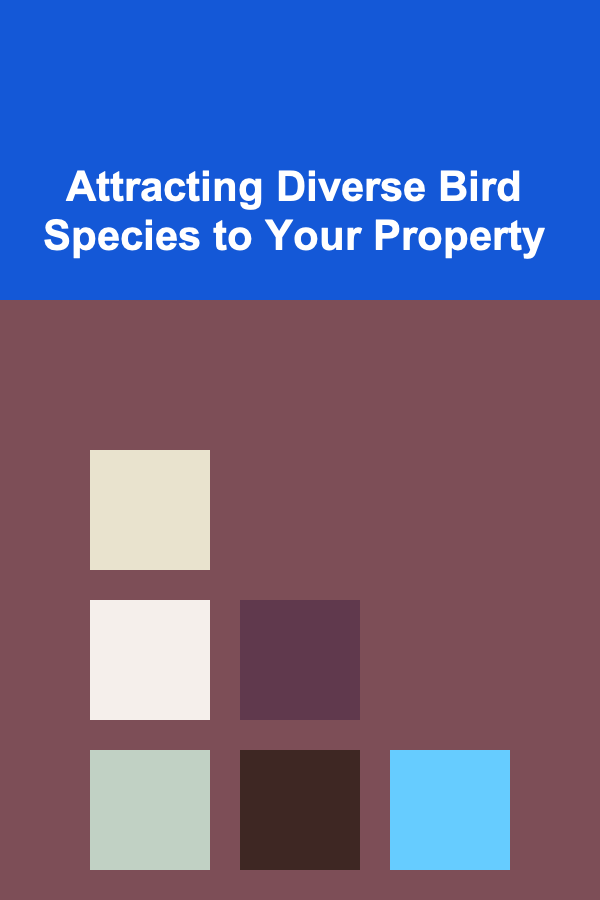
Attracting Diverse Bird Species to Your Property
ebook include PDF & Audio bundle (Micro Guide)
$12.99$8.99
Limited Time Offer! Order within the next:

Creating a welcoming habitat for a wide variety of bird species is a rewarding endeavor that benefits both your property and the local ecosystem. Birds play a vital role in controlling insect populations, pollinating plants, and dispersing seeds, contributing to a healthier and more vibrant environment. By implementing thoughtful strategies, you can transform your property into a haven for birds, attracting a diverse and fascinating array of feathered visitors. This article provides an in-depth guide to creating a bird-friendly environment tailored to attracting a variety of species.
Understanding Bird Habitat Requirements
Before embarking on a habitat modification project, it's crucial to understand the fundamental needs of birds. Different species have different preferences for food, shelter, and nesting sites. By addressing these specific requirements, you can significantly increase the likelihood of attracting a diverse range of birds to your property.
Food Sources
Providing a reliable and varied food supply is paramount to attracting and retaining birds. This includes:
- Native Plants: Prioritize planting native trees, shrubs, and wildflowers that provide natural food sources, such as berries, seeds, nuts, and nectar. Native plants are specifically adapted to the local climate and support native insect populations, which are a crucial food source for many birds, especially during nesting season. Consider the bloom times of different plants to ensure a continuous supply of nectar and seeds throughout the year.
- Supplemental Feeding: Bird feeders can supplement natural food sources, particularly during harsh weather conditions or when natural food is scarce. Offer a variety of seeds, such as black oil sunflower seeds (a favorite among many species), thistle seeds (for finches), white-striped sunflower seeds (loved by cardinals), and suet (for insect-eating birds). Keep feeders clean to prevent the spread of diseases. Consider using squirrel-resistant feeders to minimize unwanted visitors. Offering mealworms in a dedicated feeder can attract insectivorous birds like bluebirds.
- Water Sources: Fresh, clean water is essential for birds, especially during dry periods. Provide a birdbath with shallow water and a slightly rough surface for birds to grip. Clean the birdbath regularly to prevent algae growth and mosquito breeding. Consider adding a water feature like a small pond or fountain to create a more attractive and natural water source. A dripping hose or a small sprinkler can also be effective in attracting birds to water. During freezing temperatures, use a birdbath heater to keep the water from freezing.
- Insect Habitat: Encouraging insect life on your property is crucial for attracting insectivorous birds. Avoid using pesticides and herbicides, which can harm both insects and birds. Instead, promote natural pest control by planting insect-attracting plants like milkweed (for monarch butterflies and other beneficial insects) and by providing habitat for beneficial insects like ladybugs and lacewings. Leaving leaf litter in certain areas of your garden provides overwintering habitat for insects.
Shelter and Cover
Birds need shelter to protect themselves from predators and harsh weather conditions. Providing a variety of shelter options will attract a wider range of species.
- Native Trees and Shrubs: Plant a variety of native trees and shrubs that provide different types of cover. Dense evergreens like conifers offer excellent protection from wind and snow, while deciduous trees provide shade in the summer and nesting sites in the spring. Consider planting shrubs with thorny branches to provide extra protection from predators. Research the mature size of trees and shrubs to ensure they are appropriate for the available space and don't overcrowd other plants.
- Brush Piles: Create brush piles in a secluded area of your property using fallen branches and leaves. Brush piles provide excellent shelter for ground-dwelling birds and other wildlife. Ensure the brush pile is stable and won't collapse.
- Groundcover: Leave some areas of your property with natural groundcover, such as leaf litter or low-growing plants. This provides shelter for ground-feeding birds and insects. Avoid raking up all the leaves in the fall, as they provide important overwintering habitat for many insects and birds.
- Roosting Boxes: Provide roosting boxes specifically designed for birds to use during cold weather. These boxes provide shelter from the elements and can help birds conserve energy.
Nesting Sites
Providing suitable nesting sites is essential for attracting birds to breed on your property. Different species have different nesting preferences, so offering a variety of options will increase your chances of attracting a diverse range of birds.
- Nest Boxes: Install nest boxes of various sizes and designs to accommodate different bird species. Research the specific nest box requirements of the birds you want to attract, including the size of the entrance hole and the height above the ground. Mount nest boxes in a safe location, away from predators and direct sunlight. Monitor nest boxes regularly and clean them out after each nesting season. Avoid using perches on nest boxes, as they can make it easier for predators to access the nest.
- Native Trees and Shrubs: Many birds prefer to nest in trees and shrubs. Plant a variety of native trees and shrubs that provide suitable nesting sites, such as dense shrubs for ground-nesting birds and trees with sturdy branches for larger birds.
- Natural Cavities: Leave dead trees or snags standing, if they are not a safety hazard. These provide natural cavities that are used by cavity-nesting birds like woodpeckers, chickadees, and nuthatches. Ensure the snag is stable and doesn't pose a risk of falling.
- Nesting Materials: Provide nesting materials, such as dried grasses, twigs, feathers, and cottonwood fluff, in a sheltered location. Birds will use these materials to build their nests. Avoid using synthetic materials or materials that have been treated with chemicals.
Creating a Bird-Friendly Landscape
Beyond providing basic necessities, creating a landscape that is specifically designed to attract birds can significantly enhance its appeal to a wider range of species.
Plant Native Species
As mentioned earlier, native plants are the cornerstone of a bird-friendly landscape. They provide the most appropriate food, shelter, and nesting sites for local bird species. When selecting plants, consider the following:
- Diversity: Plant a variety of native trees, shrubs, wildflowers, and grasses to provide a diverse range of food and shelter options.
- Succession: Select plants with different bloom times and fruiting seasons to ensure a continuous supply of food throughout the year.
- Layering: Create vertical layers in your landscape by planting trees, shrubs, and groundcover. This provides habitat for a variety of bird species that prefer different levels of the canopy.
- Specific Needs: Research the specific plant preferences of the birds you want to attract. For example, if you want to attract hummingbirds, plant nectar-rich flowers like salvia, bee balm, and trumpet vine. If you want to attract seed-eating birds, plant sunflowers, coneflowers, and asters.
Eliminate or Reduce Pesticide Use
Pesticides can be harmful to birds, both directly and indirectly. They can poison birds directly if ingested, and they can reduce the availability of insects, which are a crucial food source for many birds. Instead of using pesticides, implement integrated pest management (IPM) techniques, which focus on preventing pest problems through natural methods. These methods include:
- Promoting Beneficial Insects: Attract beneficial insects like ladybugs and lacewings, which prey on harmful pests.
- Using Natural Pest Control Methods: Use natural pest control methods like insecticidal soap, horticultural oil, and diatomaceous earth.
- Hand-Picking Pests: Remove pests by hand whenever possible.
- Maintaining Healthy Plants: Healthy plants are more resistant to pests and diseases. Ensure your plants are properly watered, fertilized, and pruned.
Provide Water Features
As mentioned earlier, water is essential for birds. Providing a variety of water features will attract a wider range of species. In addition to birdbaths, consider adding a small pond, a fountain, or a dripping hose. These features not only provide water for drinking and bathing but also create a more attractive and natural environment for birds.
Create a Natural Habitat
Avoid creating a perfectly manicured landscape. Allow some areas of your property to remain natural, with unmowed grasses, leaf litter, and brush piles. These areas provide important habitat for birds and other wildlife. Reduce the size of your lawn and replace it with native plants. Lawns require a lot of maintenance and provide little benefit to wildlife. Creating a more natural landscape will not only benefit birds but also reduce your carbon footprint and save you time and money.
Minimize Light Pollution
Artificial light at night can disorient birds and disrupt their natural behaviors. Minimize light pollution by using shielded light fixtures that direct light downwards and by turning off unnecessary lights at night. Light pollution can be particularly harmful to migratory birds, which use the stars to navigate. Reducing light pollution can help to protect these vulnerable birds.
Protect Birds from Predators
Cats are a major threat to birds. Keep cats indoors or confine them to a fenced area. Consider using bird-safe netting to protect bird feeders from cats. Other predators, such as hawks and snakes, are a natural part of the ecosystem. However, you can take steps to minimize the risk of predation by providing dense cover for birds to escape to and by removing potential hiding places for predators near bird feeders and nest boxes. Regularly check nest boxes for signs of predation.
Specific Bird Species and Their Preferences
While the above guidelines are general, focusing on the specific needs of target species can yield even better results. Here are examples of attracting specific types of birds:
Hummingbirds
- Nectar-Rich Flowers: Plant red and orange tubular flowers like salvia, bee balm, trumpet vine, and honeysuckle.
- Hummingbird Feeders: Hang hummingbird feeders filled with a sugar-water solution (1 part sugar to 4 parts water). Clean feeders regularly to prevent mold growth.
- Water Mist: Hummingbirds enjoy bathing in a fine mist of water. Provide a misting device or a shallow dish of water.
Bluebirds
- Nest Boxes: Install bluebird nest boxes in open areas with short grass. Face the entrance hole away from prevailing winds.
- Mealworms: Offer mealworms in a dedicated feeder.
- Perches: Provide perches near nest boxes for bluebirds to survey their territory.
Finches
- Thistle Seed: Offer thistle seed in a finch feeder.
- Sunflower Seeds: Provide black oil sunflower seeds.
- Water Source: Ensure a reliable water source is available.
Woodpeckers
- Suet Feeders: Offer suet in a suet feeder.
- Dead Trees: Leave dead trees or snags standing, if they are not a safety hazard.
- Berry-Bearing Trees: Plant berry-bearing trees and shrubs.
Birds of Prey
- Open Areas: Maintain open areas for hunting.
- Perching Sites: Provide perching sites like tall trees or utility poles.
- Rodent Control: Avoid using rodenticides, which can poison birds of prey.
Monitoring and Adapting
Attracting birds is an ongoing process. Monitor your property regularly to see which species are visiting and which are not. Adjust your strategies based on your observations. For example, if you are not attracting hummingbirds, try planting more nectar-rich flowers. If you are attracting unwanted birds, such as starlings or house sparrows, try modifying your feeding practices to discourage them. Keep a record of the birds you observe and the changes you make to your property. This will help you to track your progress and to identify the most effective strategies for attracting birds to your property.
Legal Considerations and Ethical Guidelines
Before implementing any habitat modifications, be aware of any local regulations or restrictions regarding tree removal, plant selection, or wildlife management. Additionally, it's crucial to adhere to ethical guidelines when attracting birds. Avoid disturbing nesting birds or their nests. Never approach or handle wild birds. Observe birds from a distance and respect their natural behaviors. Do not provide food that is harmful to birds, such as bread or processed foods. Keep bird feeders clean to prevent the spread of diseases. Consider participating in citizen science projects, such as bird counts or nest box monitoring programs, to contribute to our understanding of bird populations and their needs.
Conclusion
Attracting diverse bird species to your property is a rewarding and beneficial endeavor. By understanding the basic needs of birds, creating a bird-friendly landscape, and monitoring your progress, you can transform your property into a haven for birds and contribute to a healthier and more vibrant ecosystem. Remember that patience and persistence are key. It may take time for birds to discover and utilize the resources you provide. By continuing to improve your habitat and adapt your strategies, you will gradually attract a wider range of bird species and enjoy the beauty and benefits they bring to your property.

How to Create a Weekly Meal Plan to Save Money on Food
Read More
How to Use Vintage Holiday Decor to Add Charm to Your Home
Read More
How To Win with Inbound Marketing
Read More
Understanding Blockchain for Enterprise Solutions
Read More
How To Simplify Your Daily Routine: A Comprehensive Guide
Read More
How to Use Credit Cards for International Travel
Read MoreOther Products

How to Create a Weekly Meal Plan to Save Money on Food
Read More
How to Use Vintage Holiday Decor to Add Charm to Your Home
Read More
How To Win with Inbound Marketing
Read More
Understanding Blockchain for Enterprise Solutions
Read More
How To Simplify Your Daily Routine: A Comprehensive Guide
Read More